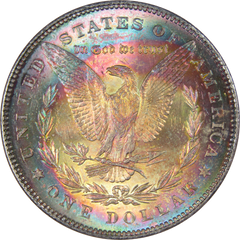Definition of Toning
First of all, what is toning? Toning is a discoloration caused by a chemical reaction between the metal on a coin's surface and the environment it's in. This reaction causes a layer of tarnish to form on the surface of the coin. It is a natural occurrence in the life of a coin and happens over many decades.
Toning on Coins
Toning can appear in many different patterns and colors. Because toning can differ greatly in aesthetics, it can either add or detract from a coin's value. For instance, a brown splotchy tone would not be as appealing and as a rainbow tone. Coins with unusual toning colors or patterns tend to be valued by coin collectors. Many different colors and patterns exist. Below are a some examples of patterns that can naturally occur.


The coins pictured here both have rainbow colored toning. The toning on the first coin is in a bullseye pattern. The toning on the second coin is in a crescent pattern. A crescent pattern typically happens when Morgan dollars have been sitting in a bag on top of each other. Therefore, only part of the coin was exposed to the elements.
What Coins Does Toning Happen To?
The most vivid toning usually occurs on silver coins, such as Morgan dollars, Mercury dimes, Walking Liberty half dollars, etc. However, in rare instances, toning can occur on nickel, copper, gold, and other composition coins.

This Lincoln cent is an example of toning that can occur sometimes on copper.
Artificial vs. Natural Toning
Now that we have discussed what toning is and how it can naturally occur, be aware that artificial toning exists as well. Artificial toning can greatly decrease the value of a coin.
Detecting man-made toning can often be tricky, but the PCGS book Coin Grading and Counterfeit Detection notes that the following characteristics are indications of artificial toning:
- The toning floats on the surface of the coin rather than having depth and being bonded to the metal.
- The toning occurs over hairlines or other marks.
- The toning exhibits bright "crayon" colors.
- The toning has a yellow-brown, smoky appearance, indicating it was caused by cigarette or cigar smoke.
What Does This Mean For Collectors?
Toning is highly subjective. While some collectors prefer that their coins have no toning at all, others find the colors to be interesting and unique. Just remember, beauty is in the eye of the beholder. The most important factor is that it has value to the collector.




